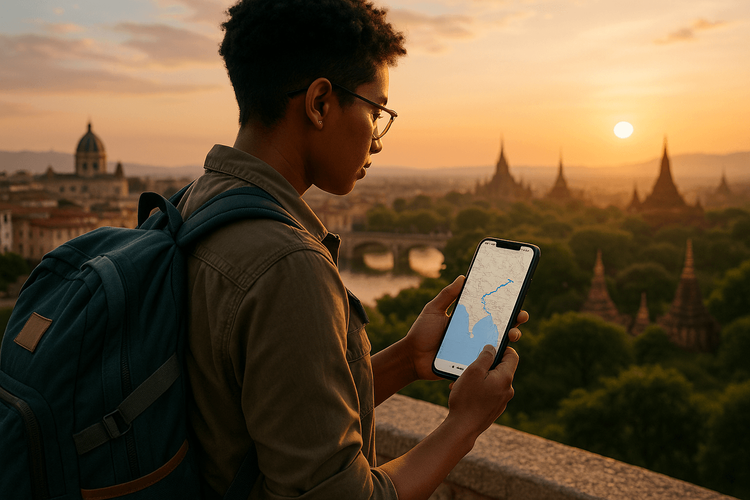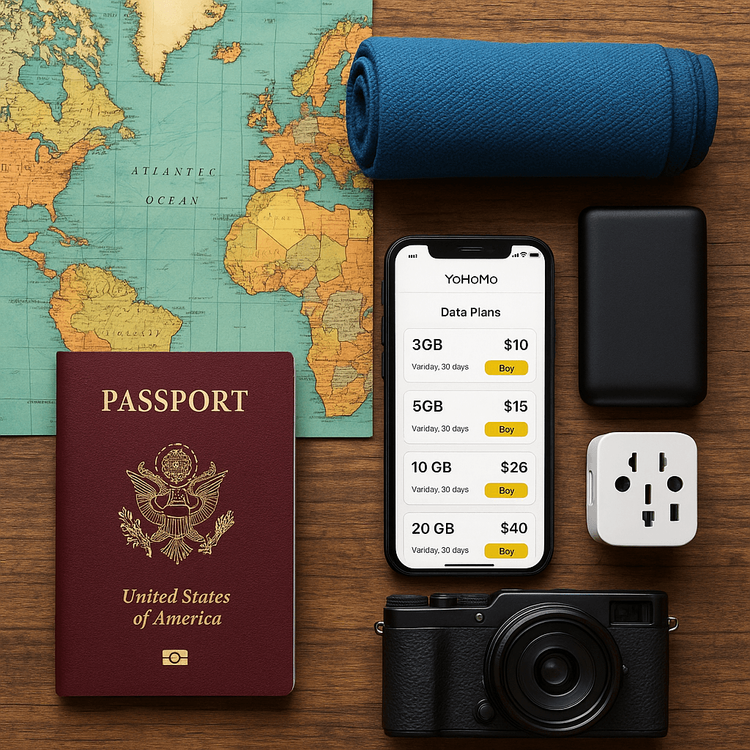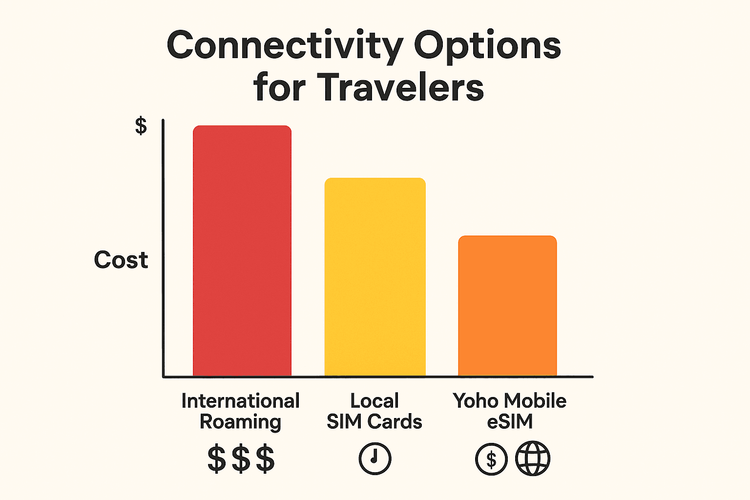国境、文化、大陸を飛び越える壮大な冒険を夢見ていますか?複数国を巡るバックパッカーの旅は一生に一度の経験ですが、最高の冒険はしっかりとした計画という土台の上に成り立っています。ビザの迷路から予算の悪夢、そして常にWi-Fiを探し求めることまで、その準備は圧倒的に感じられるかもしれません。
この包括的なガイドは、あなたのためのロードマップです。複数国周遊旅行の計画プロセスを、目的地の選択から必需品のパッキングまで、管理しやすいフェーズに分けて解説します。また、eSIMのような最新のソリューションが、旅行中の最大の頭痛の種の一つである「接続の維持」をいかに解消するかについてもご紹介します。旅の夢を現実に変える準備はできましたか?まずは計画を始める瞬間から接続が確保されていることを確認しましょう。Yoho Mobileの無料トライアルeSIMで始めるをクリックして、シームレスな接続を直接体験してください。

フェーズ1:全体像の把握 - 基礎を固める
何を荷造りするかを考える前に、まずは設計図が必要です。この最初のフェーズでは、旅全体を形作ることになる大きな決断を下すことに集中します。
目的地とルートの選択
まずは広い地域から始めましょう。東南アジアの古代寺院や賑やかな市場に惹かれますか?ヨーロッパの歴史的な都市や多様な風景でしょうか?それとも南米の活気ある文化ですか?天候のパターン、旅費、国から国への合理的な移動の流れといった要素を考慮してください。例えば、東南アジアの一般的なバックパッカールートは、タイ→ラオス→ベトナム→カンボジアといったものです。これにより、引き返す手間を最小限に抑え、移動時間と費用を節約できます。
タイムラインの設定
どれくらいの時間がありますか?1ヶ月?3ヶ月?それとも1年?あなたのタイムラインが旅のペースを決定します。現実的になりましょう。2ヶ月で10カ国を詰め込もうとすると、燃え尽きてしまいます。経験則として、文化にどっぷり浸るためには、中規模の国1つあたり最低でも2〜4週間を割り当てるのが良いでしょう。
ビザと入国要件
これは計画の中で最も重要で時間のかかる部分です。ビザの規則は変更される可能性があるため、常に大使館や領事館の公式サイトで最新情報を確認してください。東南アジアのバックパッカー旅行のビザ計画のように、複数の国を巡る旅行の場合は、以下の項目を追跡するスプレッドシートを作成する必要があります:
- あなたの国籍に対するビザ要件。
- 申請プロセス(オンライン、対面、到着ビザ)。
- 必要書類(パスポート写真、銀行残高証明書、航空券の旅程表)。
- 処理時間と手数料。
要件の概要を把握するには、IATAトラベルセンターのようなリソースが良い出発点となります。
フェーズ2:予算をマスターする
予算があなたの旅のスタイルを決定します。世界一周旅行の予算を立てることは、1円単位で切り詰めることよりも、賢い資金管理が重要です。
1日あたりの費用の見積もり
リサーチが鍵となります。生活費は地域によって大きく異なります。東南アジアでの1日の予算は30ドルから50ドルかもしれませんが、西ヨーロッパでは簡単に70ドルから100ドル以上になることもあります。Numbeoのようなウェブサイトや旅行ブログを利用して、宿泊、食事、交通、アクティビティにかかる費用の現実的な見当をつけましょう。
| 地域 | 1日の予算(バックパッカー) | 備考 |
|---|---|---|
| 東南アジア | 30ドル - 50ドル | ストリートフードは安く、ホステルも豊富。 |
| 西ヨーロッパ | 70ドル - 100ドル | 食料品店で節約可能。列車は早めの予約を。 |
| 南アメリカ | 40ドル - 60ドル | 国によって大きく異なる。長距離バス移動が多い。 |
| 東ヨーロッパ | 50ドル - 75ドル | 西ヨーロッパに比べて非常にコスパが良い。 |
旅行中のお金の管理
多額の現金を持ち歩くのは避けましょう。海外取引手数料が低い、または無料の旅行に適したデビットカードとクレジットカードの組み合わせが理想的です。カードが凍結されるのを防ぐため、必ず事前に銀行に旅行計画を伝えておきましょう。予備のカードと、少額の緊急用米ドルを別のバッグに隠しておくことも忘れずに。
フェーズ3:身軽なパッキング術
すべての長期旅行者が同意することですが、荷物は必要だと思う量より少なくまとめましょう。重いバックパックは文字通り厄介なものです。多目的で、軽量で、不可欠なアイテムに焦点を当ててください。
バックパッキングの必須アイテム
バックパック自体が最も重要な装備です。40〜55リットル程度の、快適で耐久性のあるパックを選びましょう。その他、譲れないアイテムには、速乾タオル、ユニバーサル変換プラグ、携帯用パワーバンク、再利用可能なウォーターボトル、基本的な救急セットなどがあります。より詳細なヒントについては、旅行のための賢いパッキング術に関するガイドをご覧ください。

究極のテック&デジタルノマド・パッキングリスト
現代の旅行者にとって、テクノロジーはパスポートと同じくらい不可欠です。スマートフォンはナビゲーターであり、コミュニケーターであり、カメラでもあります。それに加えて、以下のものを検討しましょう:
- 仕事やエンターテイメント用の軽量なノートパソコンまたはタブレット。
- 長旅のためのノイズキャンセリングヘッドフォン。
- 信頼性の高いパワーバンク(最低10,000mAh)。
- そして最も重要なのは、小さなプラスチック製のSIMカードを手探りで扱う必要のない接続ソリューションです。
フェーズ4:eSIMで国境を越えて接続を維持する
空港のSIMカード売り場のストレスや法外なローミング料金のことは忘れましょう。長期旅行に最適な地域別eSIMは、まさにゲームチェンジャーです。eSIM(埋め込み型SIM)とは、物理的なSIMカードなしで携帯電話プランを有効化できるデジタルSIMのことです。
複数国を巡る旅行には、地域別またはグローバルeSIMが究極のツールです。各国で新しいSIMカードを購入する代わりに、一つのプランで地域全体をカバーできます。ヨーロッパの夏ツアーを計画していますか?自宅を出る前に設定できるヨーロッパ向けの柔軟なeSIMプランを探すことをお勧めします。

Yoho Mobileなら、必要な国、データ量、期間を選んで、自分だけの柔軟なプランを作成できます。つまり、実際に使用する分だけ支払うことができます。さらに、Yoho Careのようなサービスを利用すれば、メインのデータプランがなくなっても完全に接続が途切れることはないという安心感が得られます。これはどんな旅行者にとっても完璧なセーフティネットです。お使いのスマートフォンがこの技術に対応しているか、eSIM対応機種リストで確認してください。
フェーズ5:フライトと宿泊施設の予約
ルート、タイムライン、予算が決まったら、いよいよ正式に手配する時です。
最安値のフライトを見つける
長距離フライトには、SkyscannerやGoogleフライトのような比較サイトを利用し、日程に柔軟性を持たせましょう。地域内の短距離移動には、格安航空会社、バス、電車を検討してください。ヨーロッパでは、飛行機よりも電車での移動の方が景色が良く、便利なことが多いです。
滞在先を確保する
新しい都市での最初の数泊は、事前に宿泊施設を予約するのが賢明です。HostelworldやBooking.comのようなプラットフォームは、ホステルやゲストハウスを見つけるのに最適です。ホステルはただ節約のためだけではありません。他の旅行者と出会い、現地の情報を得るための素晴らしい拠点となります。
よくある質問(FAQ)
複数の国をバックパッキングする際に、接続を維持するための最良の方法は何ですか?
eSIMが断然、最も便利で費用対効果の高い方法です。Yoho Mobileのようなプロバイダーが提供する地域別またはグローバルeSIMを利用すれば、複数の国で単一のデータプランを使用でき、現地のSIMを購入する手間や高額なローミング料金を回避できます。旅行前に有効化でき、着陸した瞬間から接続が可能です。
3ヶ月間の複数国周遊旅行の予算はいくらくらい必要ですか?
これは目的地によって大きく異なります。東南アジアでの3ヶ月(90日間)の旅行の場合、2,700ドルから4,500ドル(1日あたり30ドルから50ドル)の予算が妥当な出発点です。ヨーロッパの場合は、6,300ドルから9,000ドル(1日あたり70ドルから100ドル)を計画すべきでしょう。これには宿泊、食事、現地交通、基本的なアクティビティが含まれます。予期せぬ出費に備えて、常に15〜20%の予備費を追加しておきましょう。
大きな地域別eSIMを1つ購入するのと、国別のeSIMを購入するのとでは、どちらが良いですか?
複数国を巡るバックパッカー旅行の場合、ほとんどの場合、大きな地域別eSIMの方が優れています。国境を越える際に設定やプランを変更する必要なく、シームレスな接続を提供します。Yoho Mobileの柔軟なプランなら、特定の旅程に合わせてカバレッジをカスタマイズでき、広いカバレッジと必要な分だけ支払うという両方の利点を享受できます。
長期旅行に絶対に必要なバックパッキングの必需品は何ですか?
質の良いバックパック、パワーバンク付きのユニバーサル変換プラグ、速乾タオル、基本的な救急セット、そして信頼できるeSIMデータプランを搭載したスマートフォンです。これら5つのアイテムが、成功し、ストレスのないバックパッキングのセットアップの核となります。
まとめ:あなたの冒険が待っている
複数国を巡るバックパッカー旅行の計画は、それ自体が冒険です。全体像の把握や予算設定から、パッキングリストや接続性の確保まで、これらのフェーズに分解することで、自信を持ってプロセスに取り組むことができます。よく計画された旅行は、道中の logistical な心配からあなたを解放し、待ち受ける素晴らしい体験に完全に没頭させてくれます。
設計図は手に入りました。あとは最初の一歩を踏み出すだけです。選択肢を検討し始め、接続性を後回しにしないでください。今すぐYoho Mobileの柔軟なeSIMプランを見るをクリックして、あなたの壮大な旅が、つながり、シームレスで、忘れられないものになるようにしましょう。
